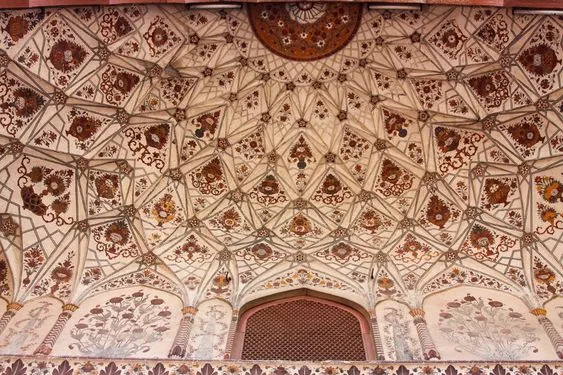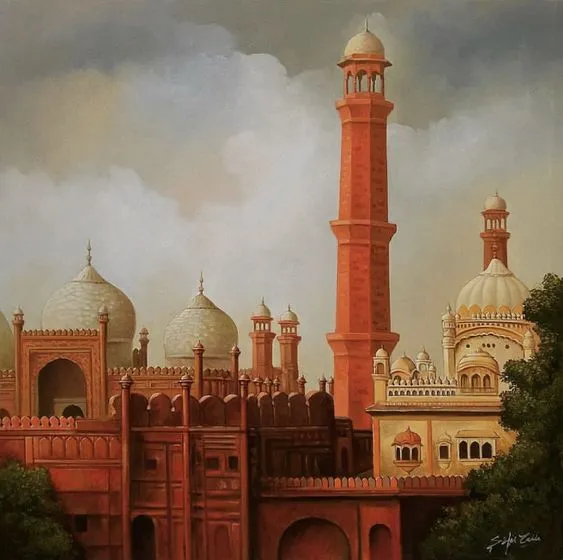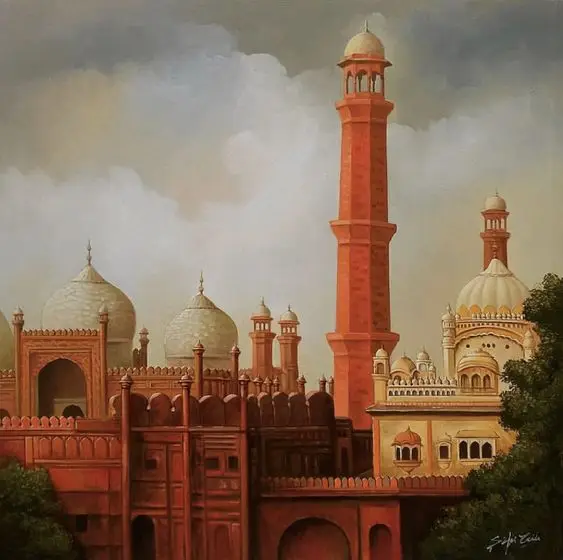Subtotal: $4398.00
Table of content :
.jpg)
History of Badshahi Mosque:
Built by the Mughal emperor Aurangzeb between 1671-1673, the Badshahi Masjid in Lahore is the largest in the Islamic world. Initially serving as a military ground during Sikh rule and later under British control, it was eventually returned to Muslims for religious practice.
Exploring the History of Badshahi Mosque
Situated in Lahore, the capital of Punjab, the Badshahi Masjid stands as the largest mosque in the Islamic world. Constructed by the Mughals between 1671-1673 under the reign of Emperor Aurangzeb, it holds a prominent place among Lahore's historical sites. Intriguingly, after its initial construction, the mosque didn't serve as a place of worship for an extended period. Instead, it became a training ground for soldiers during the Sikh rule. In the 1840s, control of the mosque shifted to the British during the conflicts with the Sikhs. They repurposed the sacred space as a military training ground. However, in later years, Muslims regained control, allowing the mosque to resume its religious significance. From an imperial perspective, the Badshahi Mosque's distinction lies in its strategic location just a hundred meters west of the Lahore Fort. The addition of the "Alamgiri" gate facing the mosque at the fort created a parade ground, where Aurangzeb would assess and review his troops. As we delve further, discover why the Badshahi Mosque in Lahore is truly a wonder of Pakistan.
Architecture and Design
Mughal architecture, influenced by construction types and regions, showcases varying materials. Unlike many less enduring structures in different parts of Pakistan, the distinguishing factor of Mughal architecture lies in the use of deep red hard stone.

For those captivated by the allure of historical building design, Pakistan stands as the ideal destination to satiate your love for art and cultural exploration. Now, pondering over who constructed the Badshahi Mosque in Lahore? The credit goes to Nawab Zain Yar Jang Bahadur, a prominent politician and leading Muslim figure, who was summoned as the architect for this uniquely designed mosque. Remarkably, it held the title of the world's largest mosque for an impressive 313 years. Stepping into the mosque's interior reveals a Persian influence, evident in the intricately carved paneling that captivates visitors right at the entrance. Thanks to its distinct and well-crafted structure, the Badshahi Mosque's architecture continues to be a subject of study in art and architectural schools. Notably, the grand courtyard of the Badshahi Mosque can host up to 100,000 people.
Minarets
If you've explored Lahore, spotting the Badshahi Mosque is likely due to its distinctive features – four major and four minor octagonal three-story minarets standing proudly at the mosque's corners. Each towering minaret reaches a height of 176 feet and 4 inches, adorned with an elegant marble canopy crowning its summit.

Museum of the Mosque
Adding to its allure, the Badshahi Mosque features a museum, counted among the finest in Lahore. This not only enhances its significance for architecture enthusiasts but also holds cultural and religious importance for the people of Pakistan.
Situated at the mosque's entrance, the museum is renowned for preserving hair strands of Prophet Muhammad (PBUH) and His son-in-law Hazrat Ali (RA). These relics bear immense religious significance for Muslims, fostering an emotional connection and reverence among visitors.
The Mughal Emblem
The central prayer hall of the mosque, adorned with red sandstone, stands out distinctively from the rest of the structure. Adding to its charm, the hall features 'Mughal Floral Frescoes' intricately embellished on the ceilings. The walls of the prayer hall are engraved with various verses from the Quran.
Divided into seven sections with multi-foiled arches and sturdy pillars, the design reflects the boldness and majesty of the founder, Emperor Aurangzeb, showcasing the architectural brilliance of the era
Tourist Attraction
Situated in the historical city of Lahore, the renowned Badshahi Mosque offers an incredible experience for tourists. As both a place of worship and a major tourist attraction, the mosque's charm has drawn attention from politicians and celebrities, including Diana, Princess of Wales, and the Duke and Duchess of Cambridge, Prince William, and Kate Middleton, during their visits to Pakistan. Built by the Mughals, Badshahi Mosque stands as the epitome of Mughal architecture. Lahore, known as the 'Mughal city of Gardens,' has long been a central hub for South Asia and ranks as the 14th most popular country globally, thanks to its rich history.

Lahore's beauty extends beyond Mughal structures, encompassing various other infrastructures that set it apart from other cities. What captivates tourists worldwide is the city's historical remnants from the times of Rajputs and Sikhs, earning Lahore the title of the cultural capital of Pakistan. Lahore's significance is further accentuated by its proximity to the border with India, making it one of the most crucial cities in Pakistan. Events like Independence Day on August 14th and Pakistan National Day on March 23rd attract numerous visitors to the border. For a delightful experience, restaurants near Badshahi Mosque offer stunning views of the mosque, coupled with delectable food, especially at night, making them an attraction for tourists and the general public. The newly opened food street adjacent to Badshahi Mosque features restaurants such as Haveli, Cooco’s den, Shahi Bawarchikhana, Fort View, Andaaz restaurant, and many others with rooftop seating, providing tourists with a clear view of the mosque while enjoying Pakistani and continental cuisine. As the last Mughal monument, Badshahi Mosque was constructed by Mughal emperor Aurangzeb in close proximity to Lahore Fort, Minar-e-Pakistan, Sheesh Mahal, and Wazir Khan Mosque. In essence, Badshahi Mosque stands as one of the most beautiful mosques in Pakistan.
Also Check out this Rana Resort & Safari Park Lahore
FAQs
is the significance of Badshahi Mosque?
Badshahi Mosque is a significant historical and cultural landmark in Pakistan, representing Mughal architecture and serving as a symbol of the Muslim community. It's a popular tourist destination in Lahore.
What is the capacity of Badshahi Mosque?
Badshahi Mosque can accommodate up to 100,000 worshippers simultaneously, making it one of the largest mosques globally.
What is the capacity of Badshahi Mosque?
Built in the Mughal architectural style, Badshahi Mosque features red sandstone and marble construction. It includes four minarets, three domes, and a spacious courtyard adorned with intricate calligraphy and floral motifs.
What is the architecture of Badshahi Mosque?
Visitors are required to dress modestly, covering their heads, and removing shoes before entering the mosque. Scarves are available for those without head coverings.
What are the visiting hours of Badshahi Mosque?
Badshahi Mosque is open daily from sunrise to sunset, with closure during prayer times.
What are the nearby landmarks of Badshahi Mosque?
Badshahi Mosque is centrally located in Lahore, surrounded by historical landmarks such as Lahore Fort, Hazuri Bagh, Minar-e-Pakistan, and the Lahore Museum.
Why is Badshahi Mosque famous?
Badshahi Mosque is renowned for its historical and cultural significance, being one of Lahore's largest and most iconic landmarks. It symbolizes Mughal architecture and Islamic heritage, attracting global visitors.
Why did Aurangzeb build the Badshahi Mosque?
Mughal Emperor Aurangzeb built Badshahi Mosque in 1673 to symbolize the power and grandeur of his empire, commemorating his victory in the war of succession against his brother Dara Shikoh.
What are three facts about Badshahi Mosque?
a) One of the world's largest mosques, accommodating 100,000 worshippers.
b) Built in 2.5 years with red sandstone and marble, completed in 1673.
c) The main prayer hall features intricate frescoes, calligraphy, and marble inlay work.
What is inside Badshahi Mosque?
Inside, a large prayer hall with a marble floor is decorated with floral motifs and calligraphy. The mosque boasts three marble domes, four minarets, and intricate frescoes and tile work, enhancing its beauty and grandeur.








Leave a Comment
Your email address will not be published. Required fields are marked *